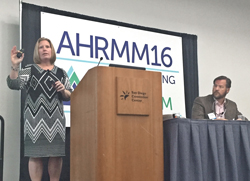AHRMM16 Features In-Depth Look At Pandemic Preparedness

Linda Rouse O’Neill, HIDA, and Marshall Simpson, Owens & Minor, discuss ongoing pandemic preparedness efforts at AHRMM16
The AHRMM Annual Conference and Exhibition is one of the industry’s best opportunities to hear leading healthcare supply chain executives and professionals outline collaboration areas with trading partners for achieving the triple aim: reducing costs, improving population health outcomes, and improving patient care quality. If you missed this year’s August meeting in San Diego, you also missed the chance to hear how distributors are serving as a vital liaison between providers and the government on pandemic preparedness efforts.
The Ebola outbreak served as a big wake-up call for the entire healthcare sector and the continued spread of Zika has amplified this concern within the industry. As a result, the session, “Pandemic Preparedness: Industry Efforts to Build Elasticity into the Supply Chain,” struck a particular chord for attendees. Linda Rouse O’Neill, HIDA, and Marshall Simpson, Owens & Minor, used the opportunity to highlight the many ways in which distributors are working with the government to enhance emergency preparedness policy and planning measures.
Recent progress drives best practices dialogue
Over the summer, distribution leaders discussed pandemic preparedness issues with congressional and federal agency representatives during HIDA’s annual Washington Summit. Reps. Susan Brooks (R-IN) and Anna Eshoo (D-CA) also hosted two expert HIDA member panels to discuss how trading partners can learn from past pandemics and prevent future inventory disruptions. Participants in all of these meetings shared their individual business experiences and noted several factors that could affect the national supply chain. Challenges identified during these meetings included:
- A lack of transparency and coordination
- Demand for medical products from the public
- Demand for non-traditional products (such as HAZMAT suits)
- Difficulties accessing non-medical supplies during a crisis
Despite these challenges, collaboration between the industry and government is improving. Rouse O’Neill and Simpson’s presentation highlighted key steps for taking part in and further improving collaborative efforts between your suppliers and government agencies. These include:
Continuing to increase transparency and communication. Your distributor has unique insight into your needs, as well as other customers’ purchasing habits. This experience can be used to advise federal leaders on how medical supplies can be most efficiently deployed during a crisis. Effectively leveraging distributors’ experience, however, requires clear direction from federal agencies on what goods are needed and available for each pandemic response.
Using distributors’ experience to strengthen existing disaster-response models. During the Ebola epidemic, federal agencies like the Centers for Disease Control and Prevention developed response plans that relied on hospital tiering, or prioritizing certain facilities to care for patients by centralizing products and services. Distributors can help with disaster preparations by developing projections for stockpile quantities under emergency circumstances and making pre-deployment suggestions. Additionally, they could develop an allocation methodology that can serve government requests. For example, an agency could inform distributors which facilities would handle the most patients during a crisis and distributors could make recommendations on how to ensure your facility, if affected, has the materials it needs.
Bringing together business and healthcare leaders to improve supply chain elasticity. Federal agencies will need help to improve national supply chain elasticity. Part of this effort involves working with you to determine what resources they will need to mount an effective response to a potential outbreak. Additionally, you, your suppliers, and federal agencies will need to work together to develop plans to allocate non-medical products such as gloves and other protective gear.
Disaster preparedness: The big picture
The most important lesson from this AHRMM16 presentation is the need for a continued dialogue to share current experiences, knowledge, and expertise. By discussing these matters with your suppliers, you, too, can become a vital resource during a crisis.
